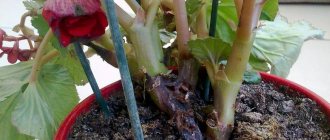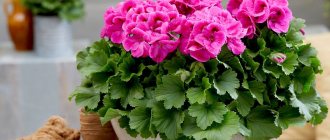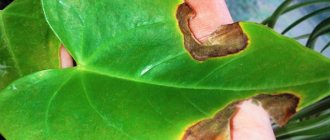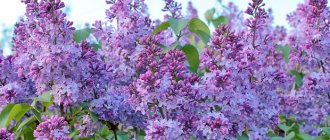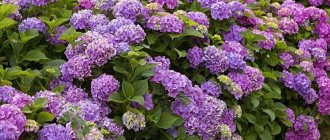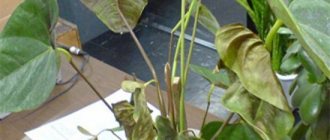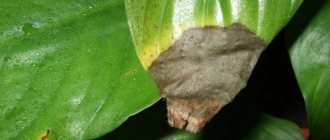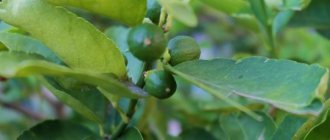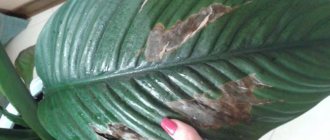How to choose soil for begonias
In nature, begonia lives in the subtropics and tropical rainforests; the soil for begonia is a mixture that contains turf, coniferous and larch soil in equal proportions, with the addition of sand and peat.
Begonia is usually planted in soil that consists of two parts leaf soil, one part humus and the same amount of peat and sand. Stores sell ready-made soil, which is called “begonia”. It is recommended to lay a thick drainage layer of small stones at the bottom of the flower pot.
Collect soil in the forest, preferably under coniferous trees, away from highways, calcine it or pour boiling water over it. Afterwards, replant the plant. It is this combination that promotes good flowering.
The air temperature in which begonia will feel comfortable is 20-22°C in summer, 16-18°C in winter. however, the plant tolerates a slight increase in it well. Home air is too dry for begonias.
Begonia prefers bright or light partial shade lighting; South-Eastern and South-Western directions are the best place for the flower.
Begonia does not like direct sunlight. They can cause burns on the foliage. To avoid leaf burns, on hot days it is recommended to protect the plant from direct sunlight.
If the flowers dry out, the leaves wither, and the color changes to red - all these are signs that the plant is hot.
Correct growing conditions
Many, especially novice flower growers, do not know that one of the features of improper care is a change in the conditions of the plant. It is very stressful for a flower if, for example, you take it out onto a loggia or balcony. Some species of this plant need to be grown only indoors; they do not tolerate open air. However, even while in the room, it happens that the begonia’s leaves dry out at the edges, turn yellow and crumble. What to do when the leaves of a begonia dry out and the bush looks very painful? If problems with leaves begin to arise after changing the location of the flower pot, then you need to immediately return the bush to its original place. It is imperative to remove damaged leaves, add complex fertilizer to the soil, after which it is advisable to place the bush in a place where there is no draft and there is good lighting. Why do begonia leaves curl in winter? Most often this happens because the flower is highly sensitive to dry air in the room. For this reason, in winter, the pot with begonia should be placed away from heaters and any heating devices. It is also advisable to humidify the air near the flower. To do this, you can spray the bush every day in winter with a spray bottle, or place a wide container of water next to the pot, which will serve as a humidifier. Why do begonia leaves fall off when the flower grows in open ground? This usually occurs due to insufficient soil moisture, as well as due to excessively dry weather. When the leaves dry out and turn yellow and begin to turn brown, you urgently need to moisten the soil, for example, with a sprinkler, which must be turned on when there is no sun in the sky. But the root system of begonia does not like excessive moisture, so it is necessary to water it moderately so that the leaves do not begin to fall off.
Proper watering
To prevent begonia from getting sick, the plant should be watered correctly; do not allow water to get on the leaves, the growing point, and especially on the flowers. Air humidification is possible using a sprayer
Watering a flowering begonia can be plentiful, but it is not recommended to over-moisten the earthen ball and allow moisture to stagnate in the pot. Water should not be allowed to stagnate in the tray, as this will cause the roots to rot. Begonia should be watered no more than twice a week in the morning or evening.
Begonias prefer to grow in high air humidity. To ensure this, the flower pot is placed in a wide tray filled with damp peat, moss or sand, and the air around the begonia is regularly sprayed, if possible preventing water from getting on the flowers and leaves.
The leaves of indoor begonia turn yellow
Why ficus leaves fall - reasons
To understand why begonia leaves turn yellow, you need to analyze its care. First of all, the cause of this symptom is excessive watering. Also, the tips of the shoots curl, gradually drying out.
If the yellow spots in the center are thinned, the plant has been burned by bright light. In summer, the begonia just needs to be moved to the shady side. But you can’t leave it without any lighting at all! If this is allowed, its foliage will turn white, the tips will turn yellow, and the shape of the leaves will become elongated.
Yellowed leaves
With the onset of warm days, some people take flowers from the windowsills to the balcony, unwittingly exposing the plants to stress. Often such changes are accompanied by transplantation into another pot, which can aggravate the situation. In response to climate change, begonia leaves will turn yellow and dry out, even losing foliage.
Blooming begonia needs feeding in the summer, otherwise its buds will look frail and not large enough. Preference should be given to phosphorus and potassium fertilizers with low nitrogen content.
Important! The amount of fertilizer is clearly indicated on the packaging - overfeeding the begonia can cause it to rot!
Among the diseases and pests that cause yellowing of foliage are the following:
- Fungus. It is determined by the presence of a white coating on the leaves and yellow spots - powdery mildew. The appearance is provoked by a lack of ventilation and high air humidity.
- Aphid. Despite its tiny size, it causes great harm to the plant; aphids are difficult to get rid of. It most often “nests” in the tops of the flower, on the back of young shoots and buds. Prevention from it is watering with nettle infusion, treatment is a soap solution.
- Spider mite. It is not so easy to detect, but an almost transparent gray cobweb is quite possible. You need to look for it in the lower part of the begonia; the leaves turn yellow and fall off under the influence of this pest.
Pests often hide on the underside of leaves
In most cases, diseases of indoor plants appear due to poor care. It is much easier to prevent them than to treat them - a mistake can lead to the death of the flower.
Fertilizer and proper nutrition of begonias.
From time to time, begonia may lack nutrients. If the leaves of the plant change their color to a lighter color and the buds fall off, this is a sign of soil depletion.
Begonias are fed once every two to three weeks with a diluted solution of mullein or ready-made organic fertilizers; to stimulate flowering, superphosphate is used as a feed. It is recommended to replant decorative deciduous begonia every spring with the addition of fresh soil.
Complex mineral fertilizers are applied in this way. During the flowering period - once every two weeks, in winter - once every one to two months. Mineral mixtures should be alternated with organic ones. To ensure abundant flowering, avoid nitrogen fertilizers, as they promote foliage growth and inhibit the formation of buds. During flowering, begonias need trace elements, potassium, and phosphorus.
Begonia is propagated by seeds (decorative flowering varieties), as well as stem cuttings (deciduous varieties of begonias) and leaf cuttings. Moreover, in the latter case, it is important that the part of the leaf used for propagation contains a large vein.
Why can leaves dry out?
Begonia is one of the most popular flowers among connoisseurs of beauty. It captivates with its leaves, flowers, and the shape of the bush. Sometimes, when keeping a plant at home, you have to provide assistance to it, since dry leaves appear, which subsequently fall off. This happens for a number of reasons - due to poor care, lack of important microelements, or the presence of diseases.
Improper care and living conditions
Your indoor plant may react sharply to changes in living conditions - for example, if you move it from a room to a balcony. Certain types of begonia will experience severe stress, which will result in leaves and flowers that are dry at the edges. What to do in this situation? It is best to put the pot back in the room, remove the damaged leaves, apply comprehensive fertilizing, and designate a place with normal lighting and no drafts.
If the problem occurs in winter, the cause is the crop's sensitivity to dry air. To increase humidity, it is recommended to place a bowl of water near the plant and spray it. During the cold season, remove the pots away from the radiator. Outdoor begonia species are also at risk. They may have dry leaf edges due to excessively dry weather or lack of moisture in the soil.
Problems with feeding plants
Trouble may arise for your flowers if you do not fertilize them. This must be done from March to September twice a month. Flowering begonias require complex fertilizer in liquid form when buds appear. When ovaries appear on the plants and abundant flowering occurs, add fertilizing with a high content of phosphorus and potassium to the soil.
The preparation should not contain a lot of nitrogen - it is not particularly useful for begonias. As for decorative deciduous species, they require nitrogenous bait. Potassium nitrate is also excellent - it should be applied no more than once every few weeks. To support the foliage when the weather is too hot, it is recommended to spray the plant with epithome, humate or zircon.
Diseases and pests
Trouble for indoor begonia can arise if it is attacked by diseases and parasites. Their appearance is promoted by errors in care and bad weather conditions. These flowers can suffer from powdery mildew. Visually, spots with a white coating are visible on the surface of the crop, which then spread throughout the entire leaf. It turns brown and dries out. You can help begonia by spraying it with morestan or foundationazole.
During the growing season, it is permissible to crush the leaves with crushed sulfur or a solution of colloidal sulfur. A soap-copper liquid prepared at the rate of 2 grams of copper sulfate and 20 grams of tar soap per 1 liter of liquid is also perfect. Gray rot may also appear on the leaves - as a result of humid and warm weather conditions, when a large amount of dust is formed.
A signal of the onset of the disease will be watery spots with a gray coating, which are visible on the surface of the leaf blade and the tips of the shoots. Then the stems break and rot. Buds, foliage and flowers become slippery and fly around. Treating begonia with a soap-copper mixture or Bordeaux mixture helps effectively. And lastly, sometimes the reason for the wilting of the lower leaves of your pet can be their death due to aging. You need to observe the culture for some time before sounding the alarm and suspecting that it has all of the above ailments.
Diseases, pests and their control
The cause of the fall of buds and flowers is various putrefactive processes and fungal diseases. This happens due to high humidity and temperature changes. Sometimes fungal spores are carried by harmful insects.
Gray rot and powdery mildew are the most common diseases of begonias that lead to the dropping of flowers.
Powdery mildew appears as light watery spots on buds, leaves and shoot tips. Against the background of a general weakening of the plant, the buds begin to fall off first, at the points of attachment to the branch.
If brown spots or a gray coating appears on the leaves of the begonia, this indicates another fungal disease of the flower - gray rot. To get rid of it, the affected parts of the plant must be removed and the rest treated with a fungicide solution.
If only the inflorescences break off, but the pedicels remain, then most likely the cause is powdery mildew. Urgent treatment of begonia with Bordeaux mixture is necessary. It contains: copper sulfate (2 grams) and laundry soap (20 grams), dissolved in one liter of water. If the disease progresses and the condition of the plant worsens, treatment should be carried out with a 1% solution of Fundazol.
Spider mites and aphids can cause leaves and buds to drop. Pests parasitize the leaves, sucking the juices from them. This leads to weakening of the begonia. The appearance of insects can be noticed and removed manually to avoid complications. Otherwise, you will have to resort to treatment with special solutions.
For severe infestations, insecticides are used. Such as “Karbofos”, “Inta-Vir”, “Fitoverm”.
If the begonia leaves dry out and curl, this means that the ambient temperature is too high with low humidity - the flower is hot. In order to help it, the air around the plant must be sprayed and its temperature reduced.
If a begonia's buds fall off or the tips of its leaves dry out, then the humidity in the air around it is insufficient. In order to increase it, it is recommended to place the flower pot in damp peat.
Begonia diseases that cannot be treated
There are diseases for which treatment does not produce results, the flower disappears. It is better to remove the affected plant so that the infection does not spread further.
Ring spot is a virus that lives in cells, it is difficult to get rid of it, because it persists in tubers, and after a while it appears again. Light green-yellow spots and streaks appear on the leaves, which turn into bronze, and dead areas appear. Flowers of a blooming begonia turn black. The only way out is to destroy the diseased plant.
Causes of plant disease
- Changes of residence.
- The plant was exposed to a draft for a long time.
- Sudden changes in temperature and humidity conditions in the room.
- They transplanted it immediately after purchase, thereby the plant suffered stress.
- Unsuitable flowerpot.
- During planting, the soil was not used; it may be acidic or heavy.
- Liquid got on the foliage.
- The cause may also be pests such as aphids, whiteflies, and spider mites.
- The plant may become sick due to fungal or bacterial infection. In which watery brown spots, or a white coating and yellow spots appear on the leaves of the plant.
Why does yellowing occur?
Begonias are considered undemanding flowers, but anything can happen in life. If the appearance leaves much to be desired, then something is wrong. Begonias often have yellow foliage, the edges begin to dry out, and then the entire leaf dies. In order to help a sick plant, you first need to understand the reasons:
- improper care;
- lack of nutrients;
- poor maintenance in winter;
- diseases and insect pests.
Transplant technology
Transplanting begonias at home is a simple matter, the main thing is to do everything correctly. So, how to transplant begonia correctly? First of all, you need to choose a suitable pot. It should be slightly larger than the one in which the plant was previously contained, but not be free - this negatively affects the root system. Next, you should choose a suitable soil mixture so that your beauty feels great in her new place.
A mixture of peat, humus, turf and ordinary soil, taken in equal proportions, is ideal. In addition, it is worth taking care of the plant that will be transplanted and providing the new location with good drainage. For this, various materials are used: expanded clay, tiles, crushed stone or even polystyrene foam, cut into cubes. Now, once all the preparations have been completed, it's time to learn how to replant begonia at home.
It is worth remembering that the procedure will be much easier if you moisten the soil in a new pot a few days before it.
Next, you need to very carefully remove the flower from the pot. To make the procedure easier, you can knock on its walls so that the earthen lump moves away from them a little and makes it easier to get it out. Shake the clod from the ground and inspect the roots: rotten or dried ones must be cut off - there will be no benefit from them, but harm is quite possible. After the unwanted elements have been removed, treat the cut areas by sprinkling them with cinnamon or crushed activated carbon.
Now you can slowly place the extracted plant in the center of the new pot. The soil should be added very carefully, making sure that neither the roots nor the leaves of the flower are accidentally broken. Don’t be afraid to compact the soil - feel free to press it down with your fingers and add a new layer when it settles. There should be no more than 1 cm left to the top edge so that you can easily water your beauty and the water does not spill over the edges. The last thing that needs to be done before the procedure can be considered complete is to water the flower generously. Do not spare water - there should be enough of it so that it begins to come out of the drainage hole. This way you will moisten the soil well, but in the future you won’t need as much water - this is a one-time procedure.
Prevention
To avoid the buds of begonias from falling off, it is enough to constantly ventilate the room, not allow the temperature to be too low, monitor the frequency of watering, prevent thrips and aphids on the plant, and also from time to time spray the plant with auxiliary substances such as a five percent suspension of copper oxychloride.
Reference. During flowering, begonia needs to be fed at least once a week with complex mineral fertilizer so that the plant does not fade and the color lasts as long as possible. It is recommended to trim wilted leaves - then the color will be more saturated.
For a good gardener, a plant is not just a decoration for a garden or room (we wrote about caring for garden begonias here, and find out how to care for a houseplant in a pot here). A flower is a friend of man, just like a dog and a cat. A flower is a pet, and like any pet, it needs proper care. Timely watering, provision of light, protection from pests - all this is important. Only with proper care will the flower grow healthy and please the eye.
If you find an error, please select a piece of text and press Ctrl+Enter.
Diseases
Begonia leaves begin to dry out and fall off due to various pests and diseases, among which are powdery mildew and gray rot. If spots with a white coating begin to appear on the begonia, then this is powdery mildew. The more this disease spreads, the larger the white spots become, which eventually merge and the entire leaf becomes white, infected with disease-causing bacteria.
If you don't fight them, the leaves turn red and dry out. Most often, foundationazole or morestan is used to combat powdery mildew; these effective drugs can be purchased at a flower shop. When the leaves begin to actively grow, they can be covered with a small layer of ground sulfur, or they can be sprayed with a sulfur solution.
Experienced flower growers spray a copper-soap liquid prepared from one liter of water, two grams of copper sulfate and twenty grams of tar soap, which are thoroughly mixed. In humid and warm weather, sometimes gray rot affects begonia, due to which the leaves of the flower begin to dry out and fall off .
The disease manifests itself in the form of watery spots with a gray coating. They appear on the tops of leaves and shoots. As it spreads, this disease affects the stems, which subsequently rot and break. Leaves, buds and flowers become slimy and eventually fall off. To combat this disease, it is necessary to spray the bush with Bordeaux mixture or copper-soap liquid.
Begonia leaves begin to dry out and fall off due to various pests and diseases, among which are powdery mildew and gray rot. If spots with a white coating begin to appear on the begonia, then this is powdery mildew. The more this disease spreads, the larger the white spots become, which eventually merge and the entire leaf becomes white, infected with disease-causing bacteria.
If you don't fight them, the leaves turn red and dry out. Most often, foundationazole or morestan is used to combat powdery mildew; these effective drugs can be purchased at a flower shop. When the leaves begin to actively grow, they can be covered with a small layer of ground sulfur, or they can be sprayed with a sulfur solution.
We invite you to read: The use of decorative wood chips in landscape design
Experienced flower growers spray a copper-soap liquid prepared from one liter of water, two grams of copper sulfate and twenty grams of tar soap, which are thoroughly mixed. In humid and warm weather, sometimes gray rot affects begonia, due to which the leaves of the flower begin to dry out and fall off .
This disease manifests itself in the form of watery spots with a gray coating. They appear on the tops of leaves and shoots. As it spreads, this disease affects the stems, which subsequently rot and break. Leaves, buds and flowers become slimy and eventually fall off. To combat this disease, it is necessary to spray the bush with Bordeaux mixture or copper-soap liquid.
Reason 2. Severe damage, death of the root system
If the root system is in poor condition, then it cannot normally transfer moisture and nutrition to the above-ground part.
The same thing happens with drying. The symptoms are the same.
The same thing happens - the leaves begin to shine, turn pale in places, and dry out the edges. And this problem can no longer be solved by watering!
And certainly no “poultices”, spraying with various zircons, epines, etc. will help begonias.
Most flower growers, seeing such symptoms, frantically begin to look for the problem somewhere outside.
They spray against pests (however, this doesn’t hurt), they are susceptible to drafts, diseases, some viruses, or even just the capriciousness of the flower.
But for some reason no one thinks to “look at the root,” that is, take the plant out of the pot and analyze its root system!
For some reason, everyone thinks that there, in the depths of the pot, everything is a priori normal. And, by the way, this is where almost all the problems of the Elatiors begin!
And here is the first example.
My plant in the photo a week ago was a beautiful flowering bush, healthy and beautiful.
But such a nuisance happened that the pot with it fell from the rack due to my crooked hands.
Well, having collected the earthen soil, grumbling, I returned it to its rightful place, because I did not see any external damage.
But my bush began to grow suspiciously weak. A glossy shine appeared, in some places the leaves had some thinning, the edges were drying out, some leaves turned pale.
As always, at first I thought that I had forgotten to water it or had not watered it enough. My soil is very loose, so it dries out in two days, but after 3 days the pots are already in the Sahara Desert.
Some people pour from the heart, but I have the other extreme.
